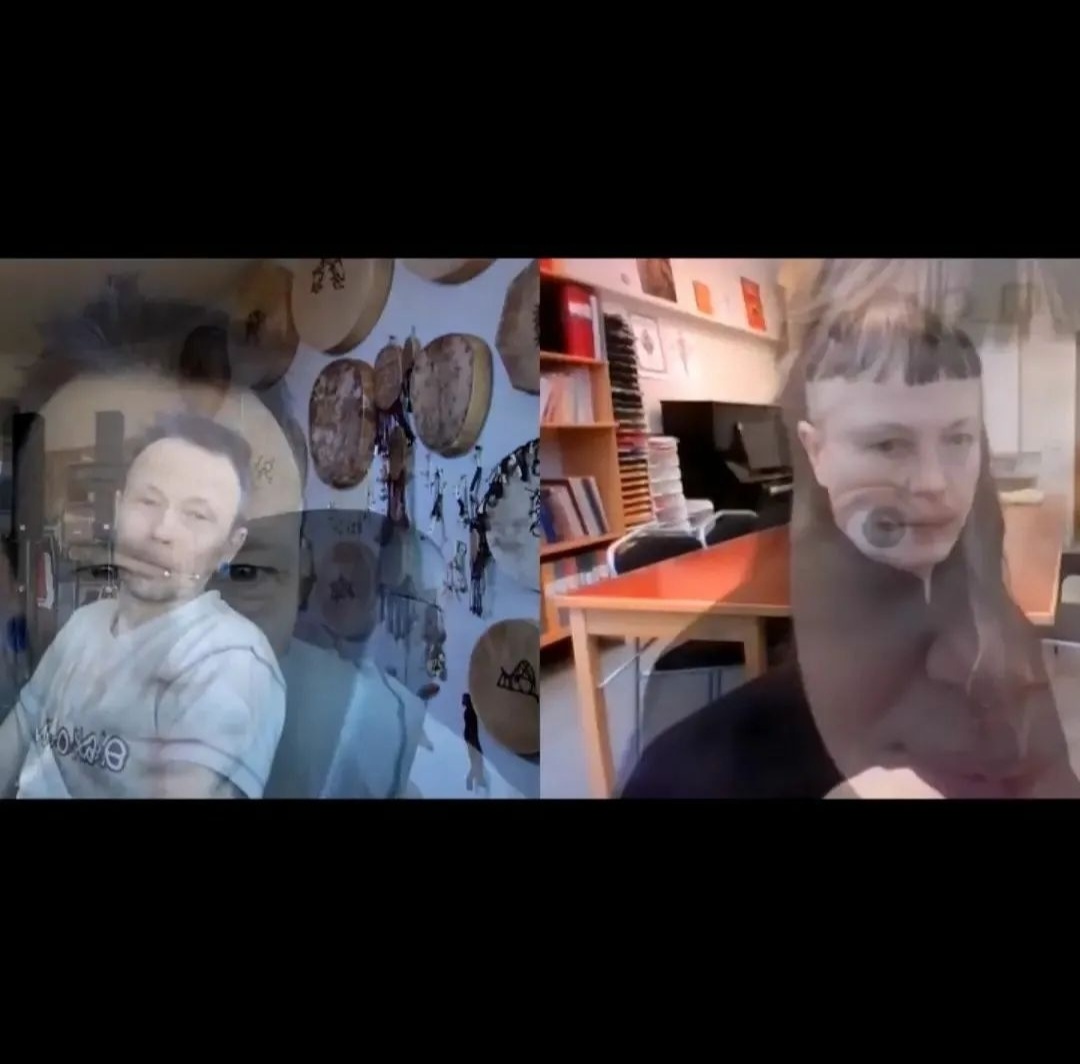
Yesterday, Ami Skånberg and Studio BuJi, invited by artist/curator Anna Viola Hallberg and curator Sibylle Feucht, owner of the gallery Das Esszimmer, created a slow intervention for Bonn together with the audience.
Information about the performance in German:
Suriashi for Bonn ist einem künstlerischen Stück, einer Performance, die wir gemeinsam erschaffen werden. Es ist Teil der Ausstellung Becoming Landscape von Anna Viola Hallberg in der Galerie Das Esszimmer von Sibylle Feucht. Ich zeige meinem Lehrer Nishikawa Senrei in Kyoto meinen Dank, der mir gezeigt hat, wie langsames Gehen das Wichtigste in der täglichen Praxis sein kann. Ich danke auch diesem Weg, der seinen Namen trägt von Clemens-August. Der Bischof Clemens-August von Galen hat sich gegen die Rassentheorien der Nazis ausgesprochen und die Menschenrechte verteidigt.
Suriashi bedeutet „gleitende Füße“ und stellt einen Spaziergang mit den eigenen Vorfahren dar, der frei interpretiert werden kann als: Wer in Suriashi geht, tut dies niemals alleine.
Wir gehen langsam, um unser Bewusstsein für den Raum und für einander zu schärfen. Ein sensibles und langsames Tempo entsteht, wenn wir gemeinsam und mit unseren Vorfahren langsam über die Brücke gehen.
Was passiert mit Ihnen, dem Raum und der Stadt, wenn wir unseren Rhythmus und unser Tempo ändern und in das Stück des langsamen Gehens eintreten?
Wer geht hinter Ihnen, wer war vor Ihnen hier?
Denken Sie an jemanden, mit dem Sie heute gerne spazieren gehen würden.
Jemand, der Ihnen unterstützt hat
Ihnen Großmutter
Ihnen Ururgroßvater
Oder Ihnen Hund oder Katze
Suriashi-Gehanleitung
Sammeln Sie Ihre Füße
Hände auf die Oberschenkel legen
beugen Sie die Knie
Schultern nach hinten Öffnen Sie die Brust
Blicken Sie zum Horizont
Zurücklehnen
Gehen Sie mit Ihren Vorfahren
Greetings from Bonn
Video: Anna Viola Hallberg
Our short documentary FAKK THE SISTEM, covering part of the vibrant Bandung Punk Scene, in the footsteps of Anti Cimex – has been selected for the 10th Too Drunk To Watch Film Festival in Berlin!
Terima kasih banyak! Gassss!


Some time ago, the archives of two editions of the International Screendance Symposium – were published – symposiums from 2000 and in 2022 – both chaired by pioneer and dance filmmaker Douglas Rosenberg.
The symposium was hosted in Lathrop Hall, the H’Doubler Theater which is home to the Dance Department at the University of Wisconsin-Madison.
It is North-America’s first university for dance. It is also an important center for screen dance/dance film.
At the 2000 Symposium you met passionate dance filmmakers, activists, educators and researchers such as Sally Banes, Ellen Bromberg, Noel Carrol, Amy Greenfield, Nuria Font, Eliot Caplan, Daniel Nagrin, Li Chiao Ping, Silvina Szperling, Elaine Summer, Laura Taler, Deirdre Towers et al. At the 2022 Symposium you met as passionate screendance people: Harmony Bench, Claudia Kappenberg, Ann Cooper Albright, Gabri Christa, Omari ‘Motion’ Carter, Charlotte Griffin, Li Chiao Ping, Katrina McPherson, Marisa Zanotti, Cara Hagan, Chad Michael Hall, Robin Gee and many more. Dance film icons Becky Edmunds, Dianne Reid (Australia) and Silvina Szperling (Argentina) attended via Zoom.
Ami Skånberg was one of the few participants who participated in both symposia. Here you can hear what she spoke about twenty-three years ago:

Documentation of Ami Skånberg’s presentation at H’Doubler Theater, University of Wisconsin-Madison 2000
Here you can hear what she spoke about one year ago:
Documentation of Ami Skånberg’s presentation at H’Doubler Theater, University of Wisconsin-Madison, 2022
Screendance festivals in Sweden
Sweden now has two dance film festivals:
Screendance Festival i Stockholm directed by screendance maker and choreographer Cyntia Bothello
and
Dansfilmfestivalen i Göteborg directed by screendance maker and choreographer Benedikte Esperi.
Screendance in education
In 2014, Skånberg wrote an article for Writing Movement, which was published in International Journal of Screendance about the importance of education of screendance for choreographers, directors, dancers and teachers. She was tired of trying to get the filmindustry to accept and support screendance, and searched for a different focus on bodies and narrative in the film medium. Today, she would like to claim that screen dance is its own genre, and that it is situated closer to dance art, visual art and experimental film than the film industry.
From autumn 2022 you can read the course Dansfilm inom dansutbildning at the Academy of Music and Drama at University of Gothenburg. Ami Skånberg, Ninnie Andersson and Karin Rickardsson took the initiative to implement it as a 7,5 credit course. In addition, Benedikte Esperi and Skånberg are teachers in the course. It is given as an independent course as well as a program course for the Dance Teacher Program in Dance at the University of Gothenburg.
Skånberg also plans to arrange an International Screendance Symposium at Stockholm University of the Arts in 2025. Keep your eyes and ears open!

CREATIVE COLLISIONS III
Encounter with New Music in Different Genres
Ami writes:
I have a thing with paper/papers. Paperplanes and post it-notes.
Autumn concert. The theme for me was exhaustion – my own, everyone’s, time’s – in dialogue with midrange sounds and algorithms from two organs. Paperplanes as messengers, messages, play.
Post-It works as a creative, pragmatic sculpture for everyday choreography, while changing the dominant design / placement of benches and tables, or the placement of technology and body or the placement od music and dance or performer and audience in a room.
Höstens konsert. Temat för mig blev utmattning – min egen, allas, tidens – i dialog med medeltonsklanger och algoritmer från två orglar. Paperplanes som budbärare, meddelanden, lek.
Post-It fungerar som en kreativ, pragmatisk skulptur för vardagskoreografi och för att ändra dominant design/placering av bänkar och bord, eller teknik och kropp eller musik och dans eller performer och publik i ett rum.

AMI SKÅNBERG DAHLSTEDT (b. 1967)
PALLE DAHLSTEDT (b. 1971)
HANS-OLA ERICSSON (b. 1958)
An artistic encounter between dancer, researcher and choreographer
Ami Skånberg Dahlstedt, composer, researcher and improviser
Palle Dahlstedt, and organist and composer Hans-Ola Ericsson. With the church’s famous meantone organ and the church space as departure points, they together created a series of works and improvisations. These included electronically modified organs as well as motion sensors for gestural and embodied playing on novel organ timbres.
The Creative Collisions part of the festival is funded by Musikverket
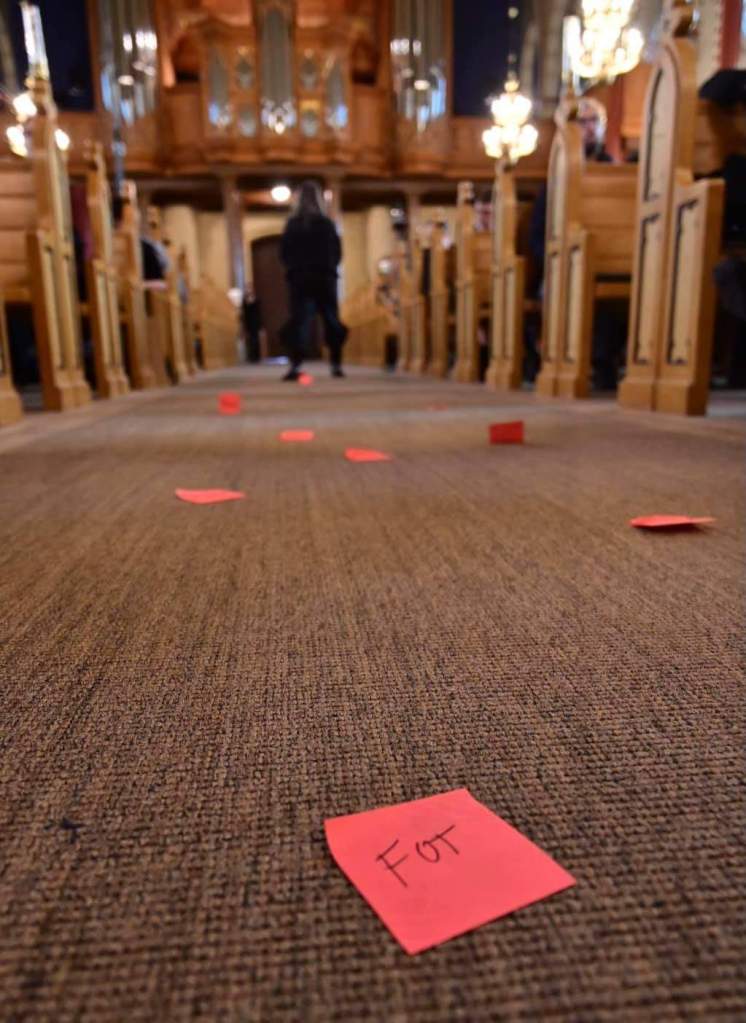


Konserten gavs i slutet av oktober 2021
Under 2019 och 2020 ägnar sig Studio BuJi åt walking art, dans- och musikimprovisation.
Läs vår senaste artikel här
Här är en dokumentation från vår medverkan i festivalen Vindöga i november 2019, Sandviken:
OtoKin by Palle Dahlstedt and Ami Skånberg Dahlstedt
Performance at the Vindöga Festival, House of Culture, Sandviken, November 22, 2019 OtoKin work was originally commissioned by the AHA Festival in Gothenburg. Oto 音 means sound in Japanese, and ear in latin, while Kin is short for kinesis, meaning motion in Greek. Motion through the ear, music and movement, or music and dance. They are intimately connected as embodied human expressions. The addition of technology makes the combination of the two both easier and more difficult, and more interesting. The path from electronic music to dance is easy to see, while the other direction is harder to tame. In OtoKin, an invisible sound space is explored through ear (Oto) and movement (Kinesis). With eyes closed, we enter a high-dimensional acoustic space, where every small body movement matters. Through this re-translation of three-dimensional body action, posture, and position into infinite-dimensional sound texture and timbre, you are forced to re-think and re-learn: Position as place, sound as motion, posture as timbre, timbre as a bodily construction. The OtoKin sound space is shared by two dancers, with added modes of presence, proximity and interaction. The performance itself, within this carefully designed performance space, is inspired by traditional Japanese performance, which we both have practiced for many years, in Japan and elsewhere. The combination of movement constraints and the limited visibility of Noh masks, with the affordances and emergent patterns of interaction in the sonified space, gives the work a very special character. The world premiere performance can be seen here: https://youtu.be/HB0AX4NSs38
Video from visitors trying out the installation version can be found here: https://youtu.be/FZgderYnUlI
https://youtu.be/cJ50sBA9NvY
Inom kort kommer boken ‘Walking Bodies’ ut där Ami Skånberg Dahlstedt skrivit ett kapitel om sitt gåendeprojekt i suriashi.
In short the book ‘Walking Bodies’ will be published where Skaanberg Dahlstedt has written a chapter on her walking project in suriashi. The book is edited by Helen Bee, Claire Hind and Phil Smith. You can order it from Triarchy Press. Du kan beställa boken från Triarchy Press
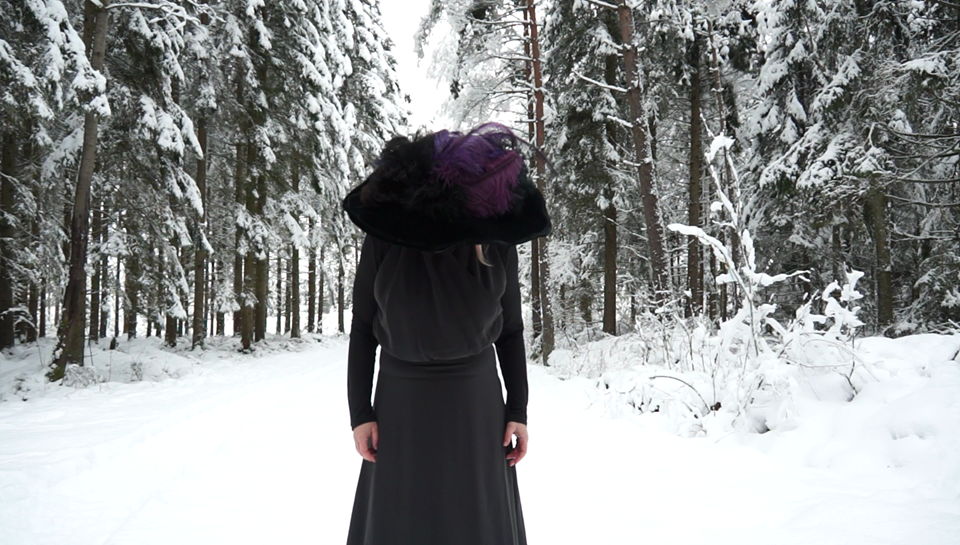
Yamanba. Premiär 5/12 på Atalante i Göteborg Foto: Meritxell Aumedes
Koreografen Ami Skånberg Dahlstedt har hört och sett tonsättaren Kajsa Magnarsson på flera festivaler i Göteborg. Både i soloverk men också i samarbete med andra koreografer, t ex Olof Persson. Skånberg uppskattar det feministiskt skulpturala i Magnarssons ljudkonst. Magnarssons ljudkonst är också performancekonst, hon bygger skulpturer av bortglömda berättelser, låter objekt med laddade betydelser hamna i dialog med varandra, t ex i skulpturen av darrande kaffekoppar:
ett pärlhalsband:
eller en strap on som bearbetar en elgitarr.
Därför är vi väldigt glada att Studio Buji har fått anslag från Kulturrådet – Samverkan med komponister – som möjliggör samarbete med Kajsa Magnarsson. Det tema som Studio BuJi arbetar med under 2018 handlar om hur kvinnlig galenskap konstrueras. Kajsas ljudkonst kommer här att stödja och bära flera scener i föreställningen. Det innebär en del fältarbete med inspelning av röster och miljöljud. Element från no-teater kommer att finnas med då Studio BuJi arbetar interkulturellt med japansk scenkonst sedan 2000. Hela gruppen bestående av konstnärlig ledare Ami Skånberg Dahlstedt, dansare Anna Bergström, tonsättare Kajsa Magnarsson, videokonstnär Meritxell Aumedes och ljussättare Åsa Holtz var i Tokyo i april för att studera Yamanba, bergskvinnan.

Yamanba i no-pjäsen Yamanba
Yamanba är en karaktär som förekommer både i no- och kabuki-teater Hon är en äldre kvinna med utsläppt vitt hår, gudinna eller demon, som vaktar bergen. Hon kan också vara ett exempel på en samhällsekonomisk lösning – äldre kvinnor som familjen inte hade råd att försörja bars upp i bergen för att dö. Det bildades myter om deras magiska krafter. Dessa myter om äldre kvinnor med magisk kraft också är ett slags att skapa kvinnlig galenskap. Det gällde att hålla sig väl med Yamanba.

Hela ensemblen studerade no med Jun sensei och Makiko sensei.
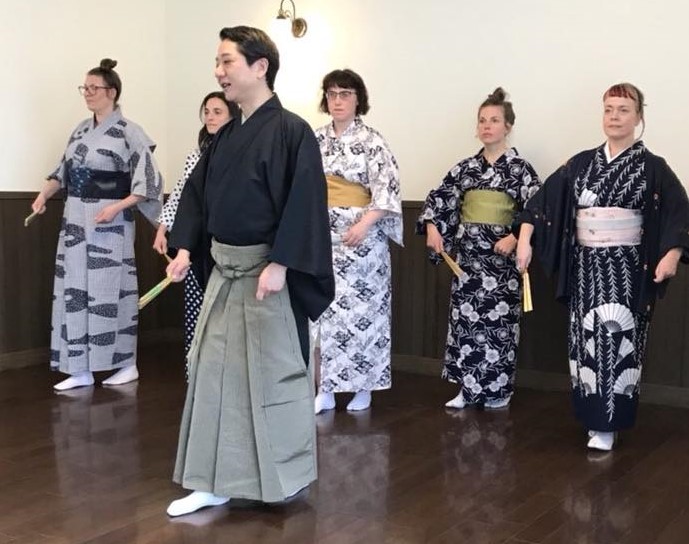
Jun sensei går igenom grundhållningen kamae och gången suriashi i no.
I no-pjäsen Yamanba (1300-tal, förmodligen skriven av Zeami) får vi följa en shirabyoshidansare som blivit upphöjd av sin publik just för att hon är bra på att skildra Yamanba. Hon gör en pilgrimsvandring för att bli en bättre dansare och möter den riktiga Yamanba. Yamanba beskrivs som hemlös, varken ond eller god och hon är ett med träden och bergen. Dansaren får en sträng performance lecture av den riktiga Yamanba om vad det innebär att göra ett autentiskt karaktärsarbete.
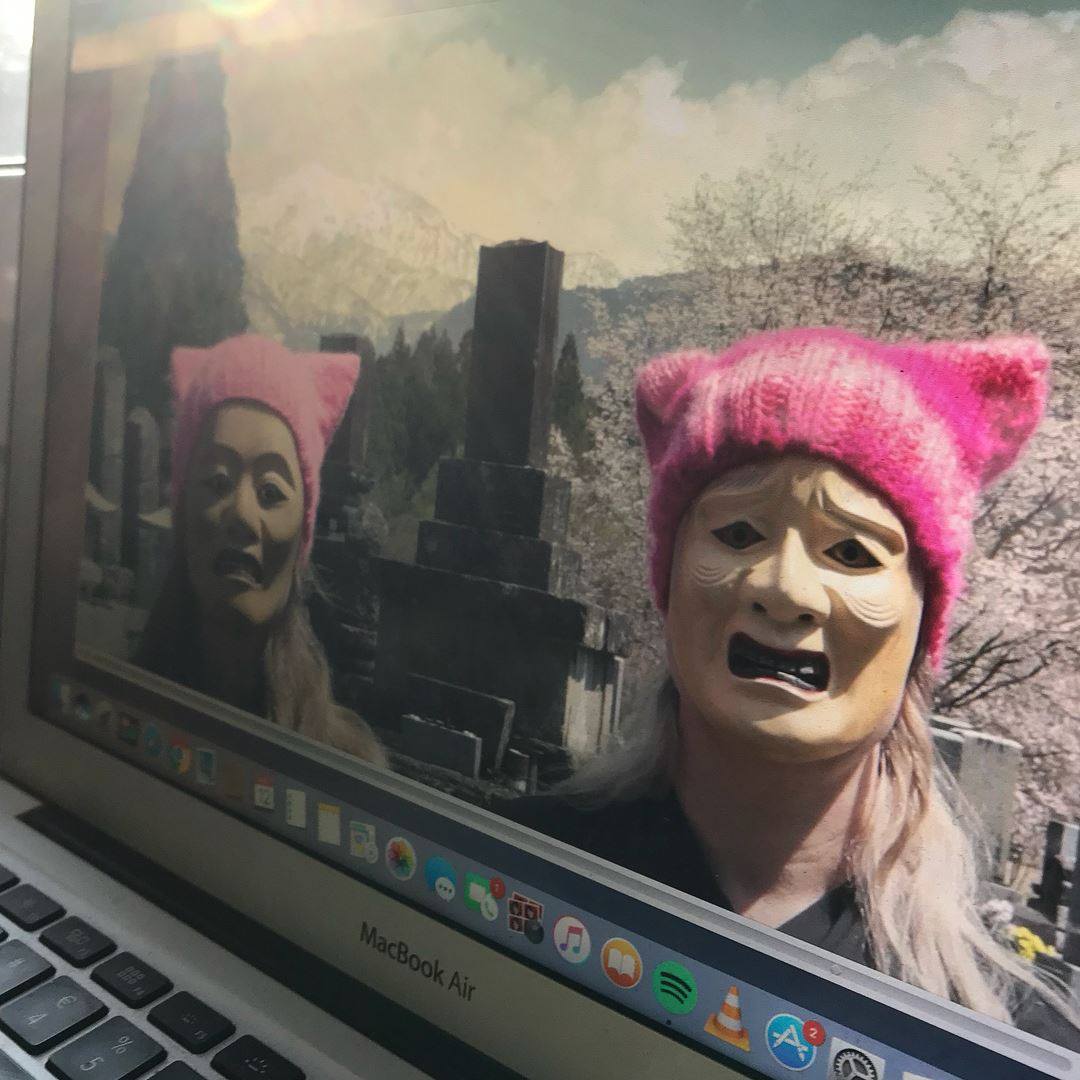
Yamanba-masker
Kajsa Magnarsson får sin första lektion i kotsuzumi – axeltrumman som är en av tre trummor i en no-pjäs – hemma hos Richard Emmert.

Aumedes dokumenterar medan Emmert ger en lektion i no-sång
I Tokyo studerade Studio BuJi även bortglömda kvinnliga konstnärers uttryck (Shirabyoshi och Onba) och japansk feminism med tonsättaren Makiko Sakurai som arbetar för mer kunskap om Shirabyoshi och som skriver nutida no-pjäser. Hon är Japans första kvinnliga Shomyo-vokalist.

Makiko Sakurai med Skånberg, Magnarsson och Holtz
Innan resan till Tokyo skapade Skånberg och Magnarsson Para Para-dans/musik för en nutida version av Yamanba. Skånberg fick hjälp med översättning av Naoko Kikui. Refrängen låter ungefär såhär:
若い女性
昔の 女性
へんなあ 女性
がんばりましょお!
och
あるこお!!
やまんば!!Unga kvinnor
Gamla kvinnor
Galna kvinnor
Kom igen!samt
Kom igen!!
Yamanba!!
Efter en lång tids letande fick Skånberg äntligen kontakt med Yamanba i Shibuya (centrala Tokyo). I Shibuya är Yamamba eller Yamanba en subkultur där japanska kvinnor flyr skönhetskravet med det eviga blekandet och vithetssminkandet. Istället sminkar de sig kraftigt solariebruna, målar vitt runt ögonen, klistrar stjärnor på kinderna, piercar sig kring munnen så att det ser ut som vårtor, bär punkig klädsel mm. En musikvideo spelades in på plats och våra nya kollegor hjälpte oss med att förstå Shibuya-Yamanba. De sminkade oss och var med oss och dansade.
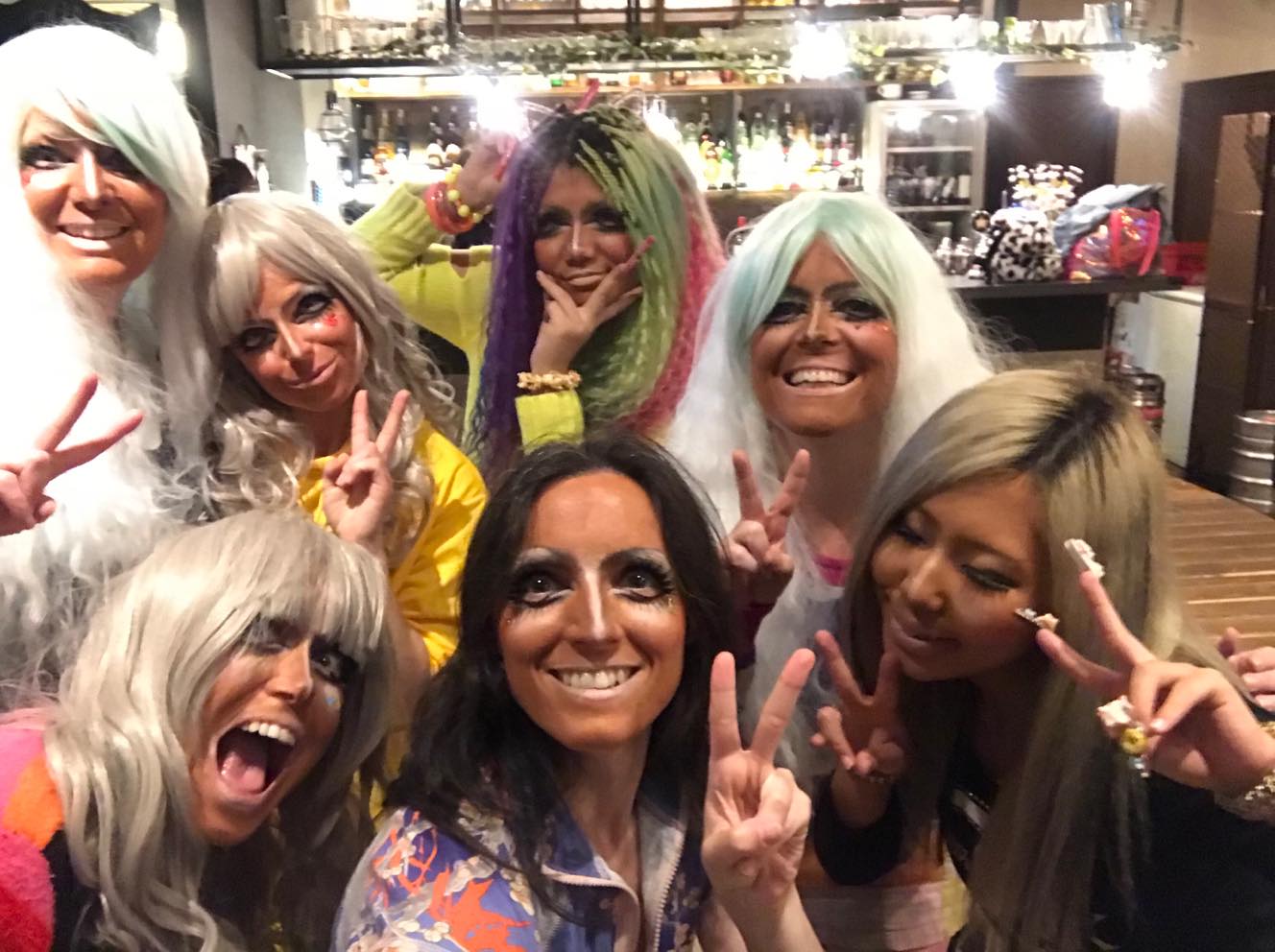
Studio BuJi med Shibuya’s Yamanba
Föreställningen arbetas fram under hela året och resan till Japan ska nu samsas med koreografi, bilder och berättelser från Småland och andra platser om hur kvinnlig galenskap konstrueras. Arbetet finansieras av Västra Götaland och Region Halland och produceras av Ami Skånberg Dahlstedt och Onyx Kulturproduktion.
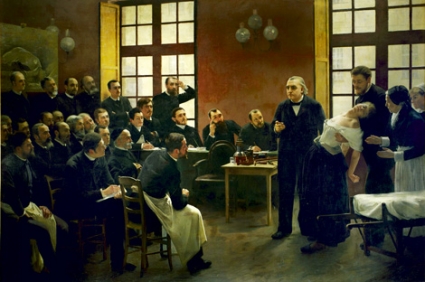
Professor Charcot visar upp hypnotiska experiment på ‘hysteriska’ patienten Blanche Wittman. Målad 1887
Idag leder jag en hyllning till körsbärsblomningen med fokuserad blomstergestaltning i den svenskjapanska allsångsdansen Sakura, Sakura kl 12, 13 och 14. Kom och dansa med mig eller kom och upplev allt hanami-relaterat som äger rum i trädgården idag. Karta:
Eventkarta hanami 2018
Hur kom allsångsdansen till? När jag pendlade som intensivast till Kyoto med min familj var mina barn små och de gick t o m på japanskt dagis. Jag ville lära mig allt om deras och mitt andra hemland och tyckte det var fantastiskt hur året ringades in av så många naturdyrkande festivaler. Hanami är en av dem. Det betyder blomstertittning. Säsongen för blomstertittning börjar tidigt, med plommon- och persikoblom i februari. Men körsbärsblomstittningen är den största och viktigaste och därför läggs prefixet ’O’ till, för att visa att det är den stora och viktiga blomstertittningen, O hanami.
Sakurasången är skriven för skolelever dels för att fira sakura men också för att fira att skolterminen börjar i april. 2001 lärde min lärare Nishikawa Senrei ut dansen tillägnad Sakura till mig. Den dansas med två solfjädrar.
2004 fick jag förfrågan från Kulturförvaltningen att skapa en utomhuslektion för åk 0-1. Det blev ett tio år långt hanamifirande med sammanlagt tretusen skolbarn från hela Göteborg. Det var till dessa museilektioner som jag skapade en allsångsdansvänlig version som alla kan dansa utan att äga de speciella danssolfjädrarna som är svåra att få tag på utanför Japan. Härnedan kan du se bilder från förr från mina museilektioner i Japandalen 2004-2014:

Vi går i suriashi till Noh-musik Foto:Jan Skånberg

Suriashi Foto: Jan Skånberg

Vi beundrar träden, stenarna och dammen Foto: Jan Skånberg
Min museilektion har också ägt rum i Melbourne, Australien och Alexandria, Egypten.

Suriashi på skolgården i Smouha, Alexandria Egypten Foto: Sherif Sonbol

Sakuradans i Smouha, Alexandria 2008 Foto: Sherif Sonbol
Från år 2014 och framåt dansar jag med alla som kan och vill varje vår på den dag som av Botaniska utses att vara O Hanami.
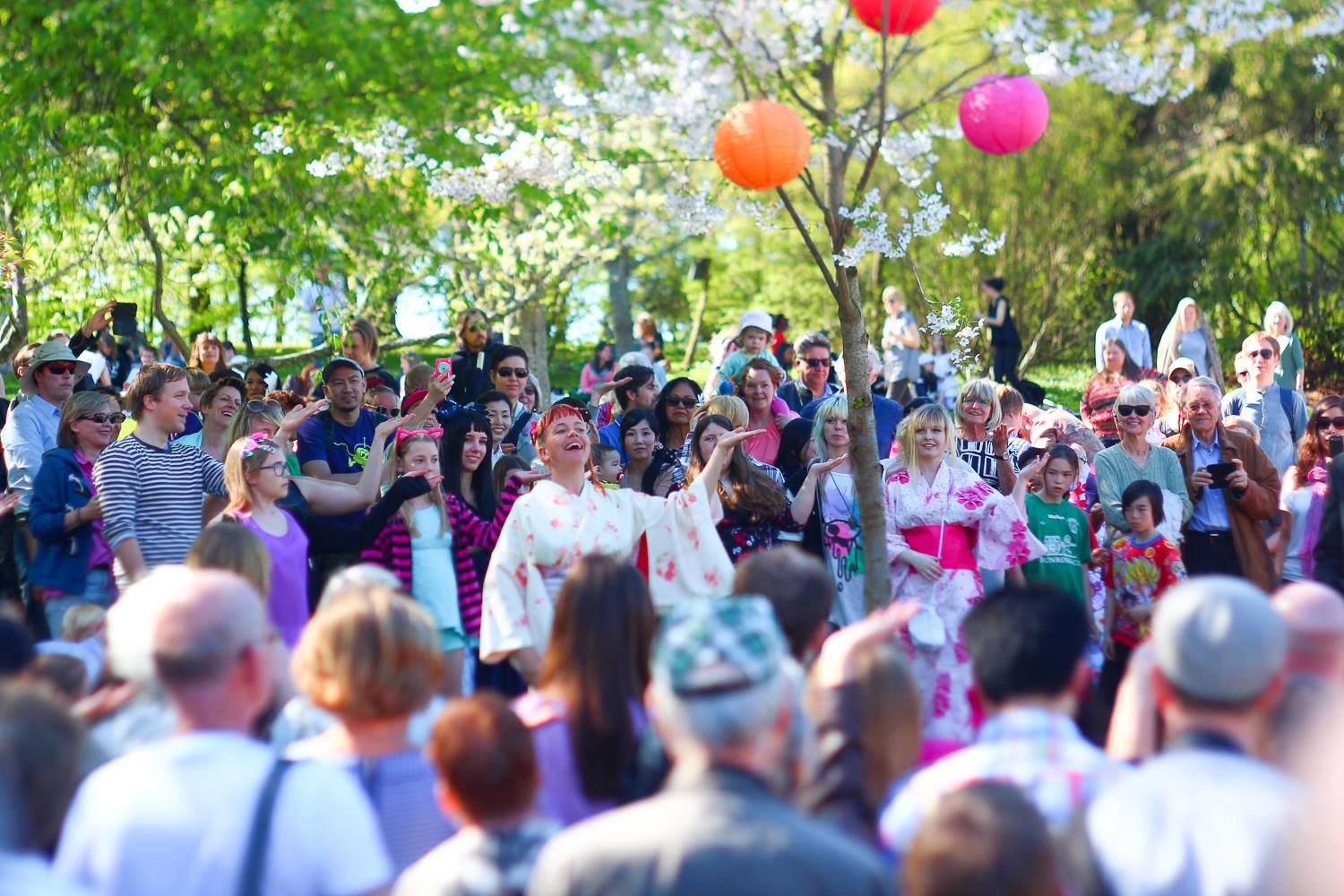
Foto: Johan Lagerqvist
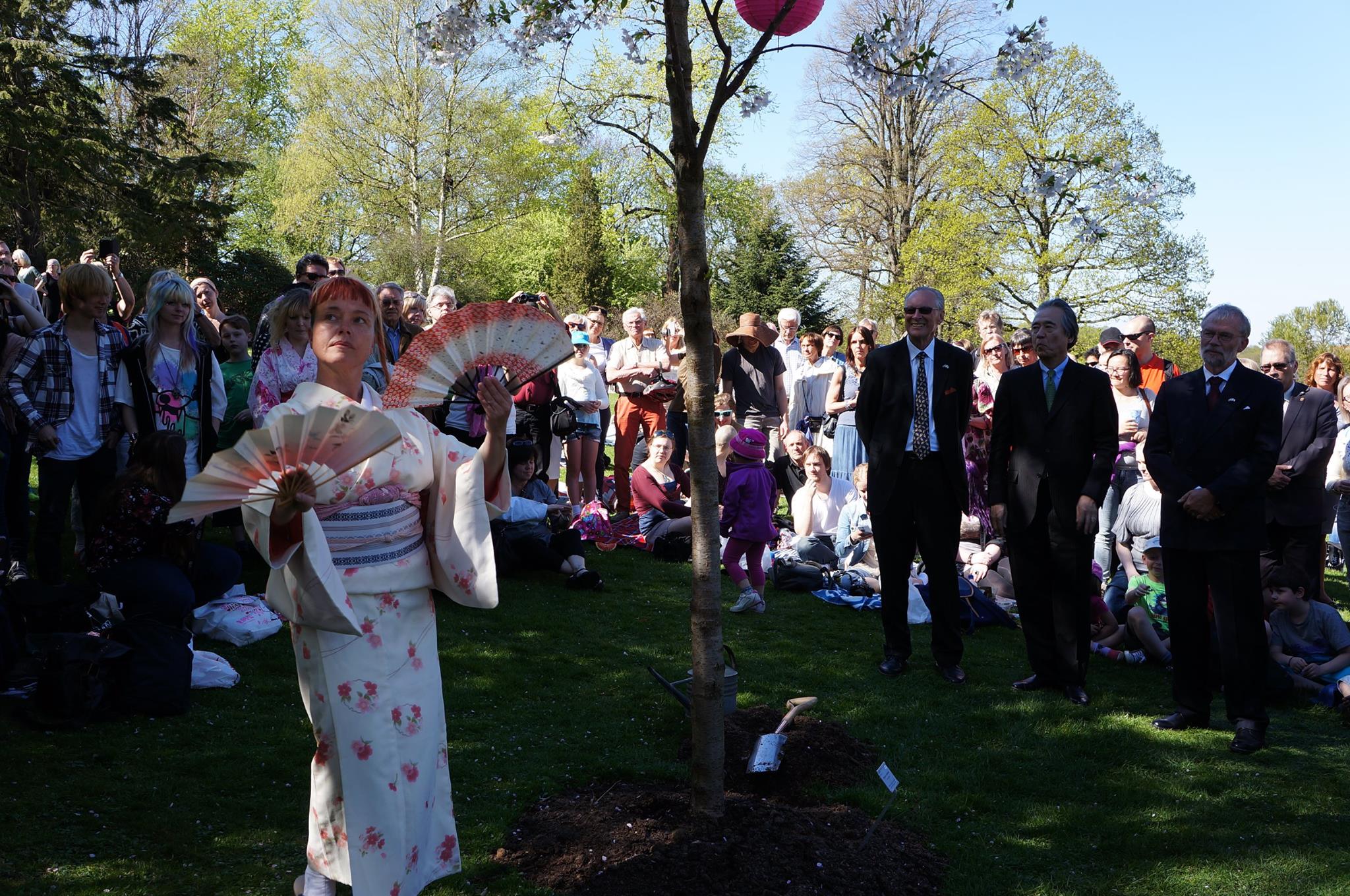
Foto: Egil Dahlstedt

Foto: Palle Dahlstedt

Foto: Palle Dahlstedt

Dear reader,
this post will be in English. It is a text I started to write in February at Ricklundgården , while I was preparing for Nordic Summer University‘s winter symposium held in Sápmi/northern Sweden for the very first time. Now I am back again to do some more work on texts and video. I think it is time to finish this text and finally publish it.
This is how the sky looks just now, Dec 30th 2017:
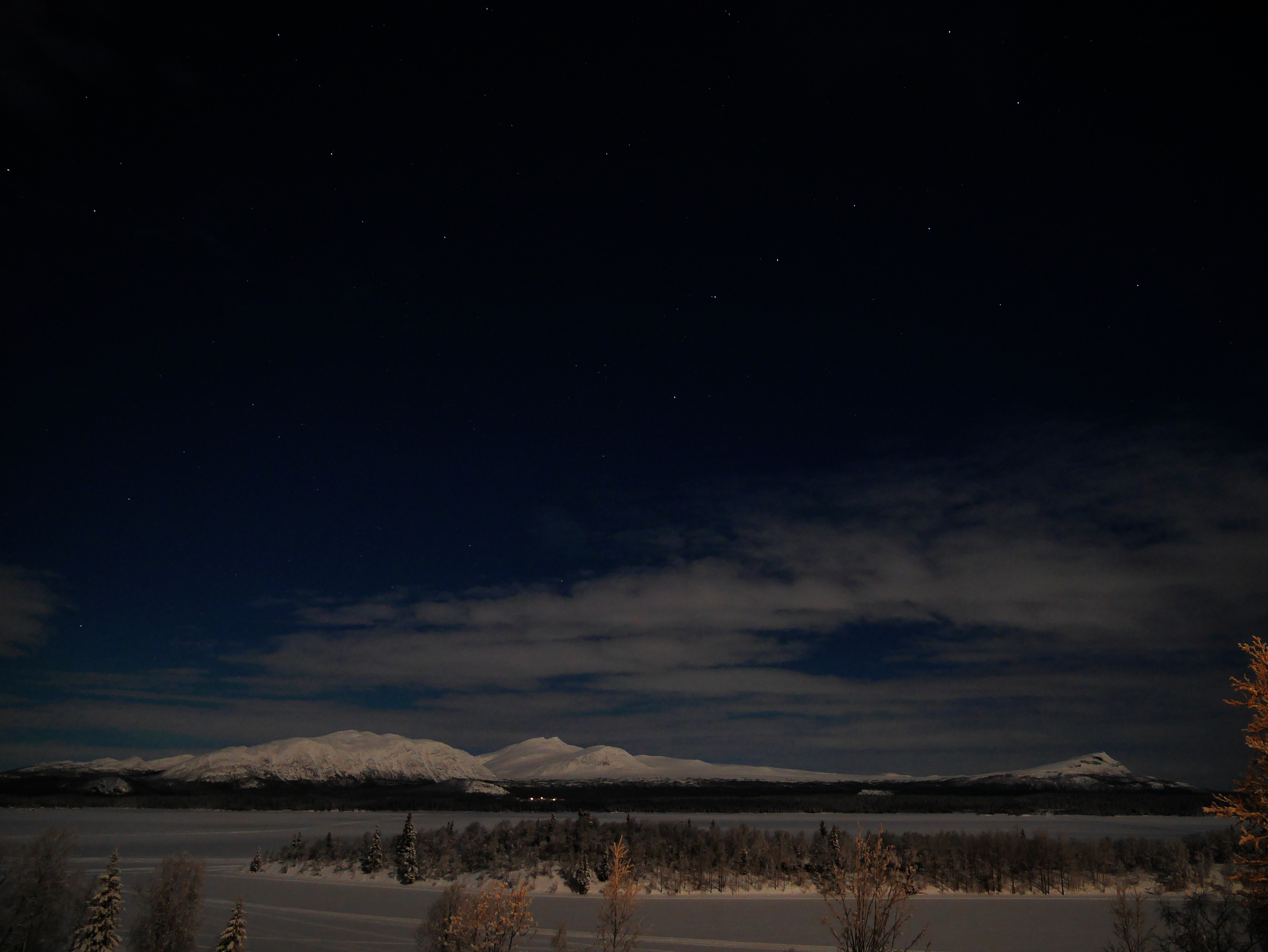
Marsfjäll in moonlight. View from Ricklundgården. Photo: Palle Dahlstedt

Marsfjäll with northern lights and meteorite on Chrismas Eve 2017 Photo: Palle Dahlstedt
Where are we? We are at Ricklundgården in Saxnäs, a home built by Emma (1897-1965) and Folke Ricklund (1900-1986) in the 1940s. Emma, originally from Saxnäs, was working at her parent’s inn in Saxnäs, when she met the artist Folke who came here to study and learn about reindeer hearding with the Sámi people. Emma and Folke were both art and nature lovers and together built this very special house in Saxnäs. After they divorced, Emma and her Sámi collaborator Lisa Stämp kept the house open for visiting artists. My connections to this place is related to the wonderful opportunity of an artistic residency that people from all artistic fields can apply for. Also, my husband Palle Dahlstedt has his roots here, and we spend each summer in this area.

First of all I would like to thank the chairwoman of the board of Ricklundgården, Gerd Sjöblom Ulander, who is also a fantastic teacher, singer and voice artist. Gerd is always so helpful, and there is nothing too difficult for her to solve. Not only did she open up Emma Ricklund’s home for the NSU Circle 7 winter symposium, but she also offered artistic residencies to four of the NSU Circle 7 artists.
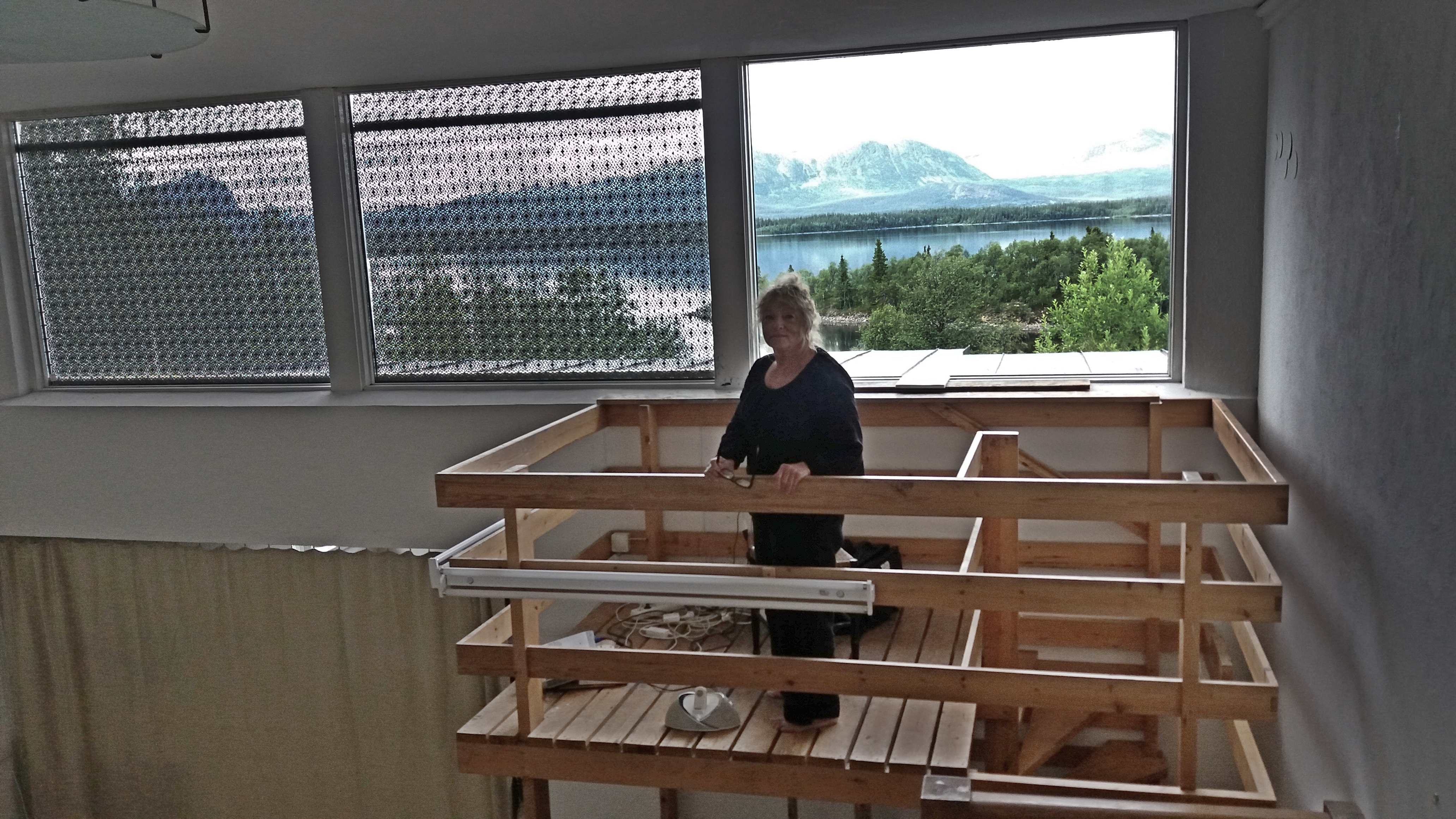
Gerd Ulander in Folke Ricklund’s atelier at Ricklundgården, 2016
This is the first time when the Nordic Summer University organizes a symposium in Sápmi. The study circle 7 consist of artists and artistic researchers from many different fields. There is an ongoing discussion about what ‘Nordic’ really means. The term ‘Nordic’ has been used as an ideological and commercial construction in which not everyone has been included. I myself grew up believing that in Sweden we are all equal, every man is a feminist, and that all social classes have been erased. I was certainly not alone believing that this was the case. Sweden has been marketed as the social democratic paradise where each and everyone is included. My co-coordinator Lucy Lyons and I hoped that by being here we would think further about place, heritage and privilege, and bring these thoughts into our future work.

Ami Skånberg Dahlstedt and Lucy Lyons in Riga, 2016
Ricklundgården
When Emma Ricklund wrote in her will that she wanted her home to remain a residency for artists, maybe she also found a solution to the dilemma of museums as a place for preservation of objects and of memory, where the risk always is that the past cannot communicate with the future. By inviting contemporary artists to work in her home, artists might become the agents for change, for exchange, for creating a link with the legacy of the museum itself, and with the legacy of the local environment.

Emma Ricklund
When we stand in the middle of Folke Ricklund’s atelier, maybe the atelier itself could be seen as a monument of the Artist, the male genius in a big room with a view, depicting Marsfjällen on canvas. However, Gerd informs me that Folke always preferred to paint outdoors. Today artists come to Ricklundgården to make videos, to read, to write, to formulate a research question, and to dance. Thus the visiting arists constantly change how this place was practiced in the past.
Sápmi
Ricklundgården was built in northern Sweden, and thus also in Sápmi, but Sápmi is not a national state. There are about 20.000-40.000 Sámi people in Sweden. It could be as much as 50.000 persons, but nobody knows exactly how many who identify themselves as Sámi. Out of these, 4.677 persons are caretakers of the reindeer. In Norway there are about 50.000 – 65.000 Sámi people, in Finland about 8.000, in Russia about 2.000. Not until 1977 did the Swedish Parliament pronounce that the Sámi people are an indigenous people in Sweden, even though the Sámi have been here for thousands of years. In 2000, there was a new minority language law for Sweden’s five national minorities, where the Sámi language was recognized at last. And finally in 2011, the Sámi people was recognized as ‘a people’ by the Swedish constitution. This recognition of being pronounced ‘a people’ additionally means legal protection. Sweden has finally recognized that the Sámi are a people, an indigenous people and a minority.
Today we start to be aware how “voyages of discovery” were in fact voyages of invasion. One example of these voyages of invasion in the Scandinavian countries is the colonization of Sápmi, in Sweden called Lapland. Sápmi was seen as ‘the space out there’, and a lot of effort was being made to create a national place out of this ‘unknown’ abstract space. In this case it also meant a Christian place, where everyone must speak the same language, give up ‘pagan’ singing and dancing, and pray to the same God – ‘real’ and valued practices. Adding on to that, during the 18th century, Sweden’s central government’s debt grew and inflation was high. The northern part of Sweden is rich with resources, and the government decided upon the building of ore mines as a way to pay some of the depts. This is when the forced recruitment and the oppression of the Sámi people began.
The young Sámi generations are at this very moment reclaiming their own history by relearning the Sámi language and the crafts once forbidden by the non-secular Swedish state. Some are looking for ways to continue reindeer herding and to make a living without having to move to bigger cities. Tourism is one solution, but with it comes issues on how space is practiced and performed. When indigenous people struggle to make a living in a space invaded by colonialists, and decades later are asked to perform an authentic illusion of the past, it often leads to a commercial construction of space. The new generations’ reclaim consists of different alternatives and practices for change, i.e. to make a new context out of space-specific ‘old’ practices. This is visible in the contemporary arts practices by Sámi artists such as Katarina Pirak Sikku, Hilde Skancke Pedersen, Tanja Andersson, Ola Stinnerbom, Saara Hermansson, Silje Figenschou Thoresen, and Amanda Kernell.

Saara Hermansson, Västra Stornäs
Contemporary Sámi artists
I will share how some contemporary Sámi artists have reflected artistically on the environment, on heritage and legacy. This is Hilde Skancke Pedersen next to her art work that she created for the Sámi Parliament:
We screened her art film EANA (Sámi for “land”) at the winter symposium. Hilde works in various materials, and is also involved in cultural politics. She lives in northern Norway/Sápmi, and she is a representative at the Sámi Artist Council. She presents her work with the film here:
‘In the film EANA a naked, female body mirrors the shapes of the landscape in the Sámi hinterland. The film addresses the similarities between an ageing body and the rugged mountains, and the close bond between humans and nature. The Sámi culture is closely connected to nature, and the fight to preserve Sámi areas from exploitation is ongoing. This struggle is supported by a majority of the Sámi population, while feminists and homosexuals still suffer from prejudice. In some Sámi communities, the church does not employ female vicars. In Sámi society, privacy and a strict bashfulness has ruled since the Christian religion took hold in the 18th Century. The traditional way of dressing, strictly covering the body, is still in daily use among many elderly people, and is often used by all ages for festivities. In contrast, many young women are scantly dressed for evenings out, in accordance with current fashion, often dancing to Sámi rap music with explicit sexist lyrics. Until recently, the Sámi female body was accepted regardless of size, shape and age. My aim is to research the paradigm shift in this field.’

Silje Figenschou Thoresen
Silje Figenschou Thoresen is trained in contemporary art at Scandinavian art schools. She works conceptually as a Sámi person, and she is using Sámi inventions for contemporary art – a decolonial maneuvre to be able to eat and keep the cake. She argues herself that she is taking Sámi art and moving it into contemporaneity. Her fundamental ethos is the respect for nature, and not to let anything go to waste. Sámi-self-sufficiency, utility projects and the self-reliance of a people with limited resources and an inherent DIY- mentality are the starting point in her work. These are her sculptures:
The artist Katarina Pirak Sikku really tried to come and present her work at the NSU Circle 7 winter symposium in Saxnäs. She had just received her first research grant from the Swedish Research Council, and would have loved to replace her small workspace in Uppsala to Saxnäs. She has had residencies at Ricklundgården before. Her family is from this area. In Katarina’s artistic practice, she is processing dark Swedish history. She has been looking for her own mental independence, and finally decided to start to work with rasbiologi, in English racial biology or eugenics.

Katarina Pirak Sikku with tools for craniometry
In 1922, the National Institute of Racial Biology was established in Uppsala in order to document the Swedish population. Herman Lundborg was the leader of this institute until 1935, and he was particularly interested in people of northern Sweden, where a large part of the population was a mixture of the Sámi, Swedes and Finns. Herman Lundborg looked for evidence that ‘racial mixtures’ had bad consequences. Before he became a professional racist, he was the head of the women’s department at the psychiatric clinic in Uppsala. His writings had a huge impact, and he had a big readership outside the traditional science field. Besides writing, he traveled around and measured and photographed both children and adults while exhibiting ‘racial types’ and different kinds of people’s typical appearances, which survived in people’s minds long after his death. The notion that the Swedish race was being degenerated, and that this must be combated resulted among others the introduction of sterilization law in 1934 (not abolished until 1976). The National Institute of Racial Biology remained until 1958, and Lundborg’s methods was being implemented and used by the Nazi during Second World War. During these dark twenty-three years this institute caused great harm to a lot of people.
Katarina Pirak Sikku looked through the archives, where she found endless photos of Sámi people without names. She looked at Sámi handicraft, and there were no names of the craftsmen. She found a bag that her grandmother had made, and she wondered if she should be grateful that someone had preserved it and put it in a museum? She could not be grateful, she did not want to be grateful. She found it very difficult to work with these photos, and during the work she realized that her intention was not to write the history of racial biology in Sweden. Instead, she wanted to talk to people, and to find someone who might remember what had happened during this time. She also wanted to find out how it felt to be measured. She started to take pictures of herself with the original measurement tools that she borrowed from the archives.

Katarina Pirak Sikku also wanted to look at the Sámi self-image. But how? She was not sure. Shouldn’t she start to photograph Swedish people instead, posing with cows – in order to show the absurdity of depicting people in ‘authentic’ ways? Katarina loves the Sámi handicraft, for example the embroidering with the tin thread on broadcloth. She also loves the fact that there are so many strict handicraft rules. At the same time, she was also very upset with the Sámi handicraft, and with the many rules. She decided to make a provocation, something to upset everyone. Katarina worked with pearl embroidery, and created a Sámi bikini and took a photo of herself. She felt that some of her anger disappeared after she took the photo, and that it helped changing her self-image. Katarina thought that this photo helped her to think of a contemporary identity, a different self-image.
Saara Hermansson, a young Sámi activist from Västra Stornäs, also talks about the self-image and what happens when you try to find something that has been lost. Can she use old Sámi patterns in her embroidery, even if they are not clearly from her own family? She mentioned the word ‘koltpolis’ in her speech. A ‘koltpolis’ (frock police) is a person from the Sámi community who acts like a police in an attempt to control the authenticity of the Sámi clothing during informal and formal gatherings, festivals and markets. Saara also talks about identity and jojk, please see an excerpt of her speech at Ricklundgården here:
Just before the symposium started, a new film by the Sámi film director Amanda Kernell premiered in Sweden, called Sámi Blood. I watched it in Vilhelmina together with Saara Herrmansson. Like Katarina Pirak Sikku, Amanda Kernell is dealing with the ‘forgotten’ or actually repressed history on how Sámi people were treated in the 1930:s in Sweden with a focus on Nomad schools (lávvu schools). Nomad schools were invented for the children of reindeer farmers. They could not go to the same schools as Swedish children or as Sámi children without reindeers. The pupils often had to stay in badly insulated goahti (Sámi huts), since the idea was that if they stayed in houses they would become like Swedes. In these schools and in the Swedish schools, the Sámi children were forced to speak Swedish and not allowed to speak their native language. The film shows how Lundborg’s fake research on racial biology was implemented. Children were divided based on ethnicity and family background, which caused the fragmentation of the Sámi culture that we see today. The film follows Elle Marja, a 14-year-old reindeer-breeding Sámi girl. Exposed to the racism of the 1930’s and the race biology examinations at her boarding school, she starts to dream of another life. Watch the trailer here:
In SILVERFEBER (Silver fever), the choreographer Tanja Andersson was probing colonial traces in the physical body and scattered identity. Silver fever takes off in the 17th century in Northern Sweden – Sápmi, when silver was found in the area of Nasafjäll. Subjugation and enslaving of Sami people initiated by the state of Sweden began. A variation of the torture method Keelhauling was practiced on the ones who refused work. Tanja is looking for a social and cultural inheritance, silenced for such a long time. How will experiences unfold in the passing down from generation to generation? In what ways will it be expressed corporeally? How does it affect movement?

Tanja Andersson and Emelié Sterner in Silver fever 2017
There is something in my blood. It rivers around, impossible to divide. Felt like undercurrent in white-water but it is my old man, it is you. It might be grandpa when he fell through the ice and came back, or it could be the uncles – those who lingered beneath the streaming surface. It must be the women, tough and hard-baked, for now we slowly lift our chins. I hear the sound of joik but I can’t sing along. Never learned the language since they hit you ‘til you stopped talking. A tremor in the torso with bones longing to fracture. A man borrows my vocal chords before he, with tightly bound wrists, is dragged into the freezing cold water.
In Swedish:
Det rusar runt, runt och går inte att sortera. Trodde det var underströmmar i forsen men det är farsan, det är du. Det kan vara farfar när han gick igenom isen och kom tillbaks eller kanske farbröderna – de som stannade kvar under vattenytan. Det måste vara kvinnorna, de starka och hårdbarkade, för nu höjer vi sakta hakan.” En skälvning i överkroppen med ben som längtar efter att spricka. En man lånar mina stämband innan han, med tätt ihopbundna handleder, släpas ner i det iskalla vattnet.Tanja Andersson
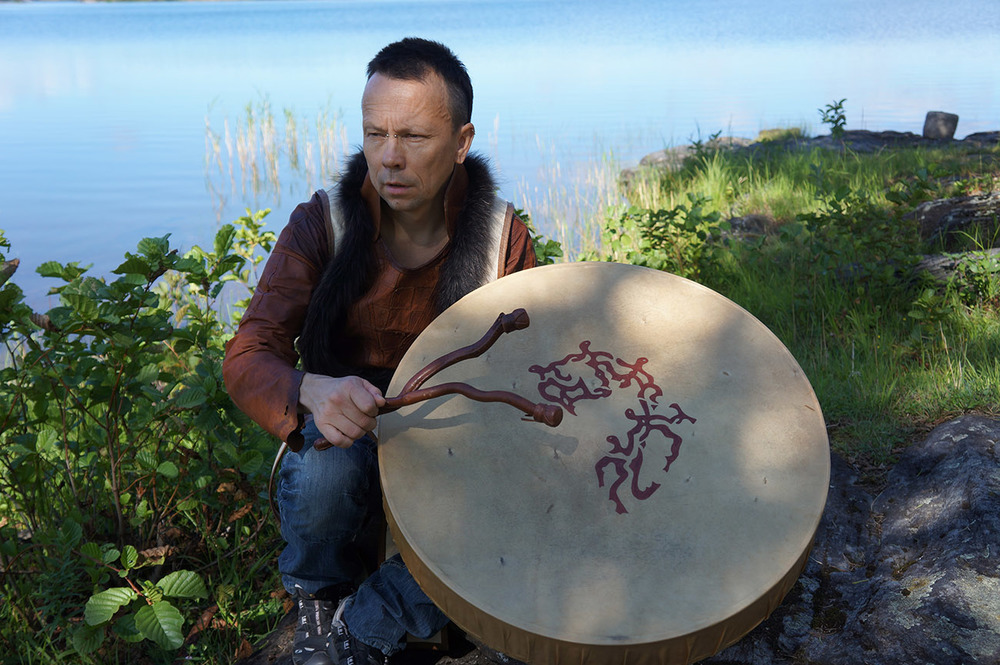
Ola Stinnerbom
Ola Stinnerbom is a contemporary choreographer, dancer and jojk singer who lives in Gothenburg. His family is also from the area around Saxnäs. In his work, he is researching forgotten Sámi dances, and he is also recreating Sámi drums. Together with Birgitta Stålnert, writer, filmmaker and a researcher of cultural studies, he runs Kompani Nomad. They want to change the image of what Sámi culture is and can be, with a particular focus on Sámi dance. They aim to show that Sámi dance existed, and to reinstate the Sámi dance tradition. Not in a strictly historical sense, but in a contemporary innovative form. Watch excerpts from ‘They call us Lap Ogres’:
All of these amazing artists show how they are able to combine activism and arts practices, and thus help change the discourse on Sámi identity and self-image. With their work they are involved in an international discussion on the major political changes caused by migration, nationalism, and debates on ethnicity. The Sámi artists are at the heart of the issues, which the art world today is very interested in.
My own connection to Saxnäs
I am not Sámi, and my family is not from Sápmi or from northern Sweden. Instead, I am the great grandchild of a failed immigrant from the southern part of Sweden, Småland. The further you were form the centres of power, the easier it was to be regarded as degenerate or lowly, this was also the case for southern Sweden. My great grandmother Viktoria left Sweden at a time when many Swedes emigrated to seek a new life in North America. Her siblings stayed in the U.S., but Viktoria returned by herself, and it is unclear why she came back. There has been a lot of silence and hidden trauma in my own family, indeed caused by the ideas of the pure race, and this is why I also relate on a personal level to many of the problems that young Sámi people are bringing to the surface. I will work with this trauma for my next performance ‘The Crone/Yamanba’.

Lars Dahlstedt 1855-1915
My connection to this place is through the artist-in-residence at Ricklundgården, and through my husband’s great-great grandfather Lars Dahlstedt. He was a priest in Vilhelmina and Fatmomakke. Lars was a prolific amateur photographer who depicted the life in Sápmi. You can find his photos in the Fatmomakke museum, in Vilhelmina and Umeå museum, and in many journals and books. Lars was also very interested in technical development, and could be seen biking around on a high wheel bicycle. He would always bring the bellows camera. About one hundred years after his death his great great grand child Palle Dahlstedt is looking at photography as a tool for artistic research and musical composition.
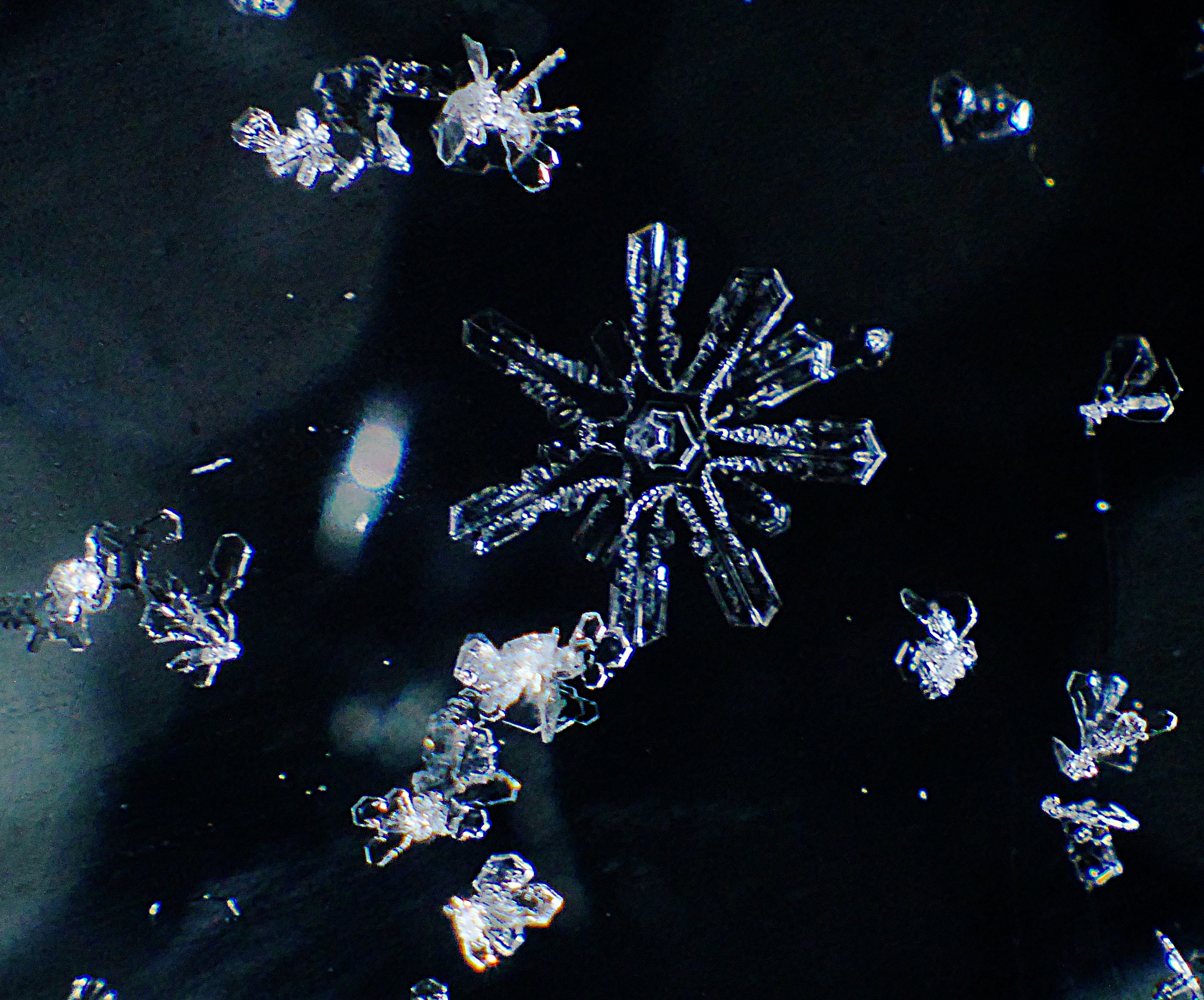
Snowflakes on the stairs of Ricklundgården 2017 Photo: Palle Dahlstedt
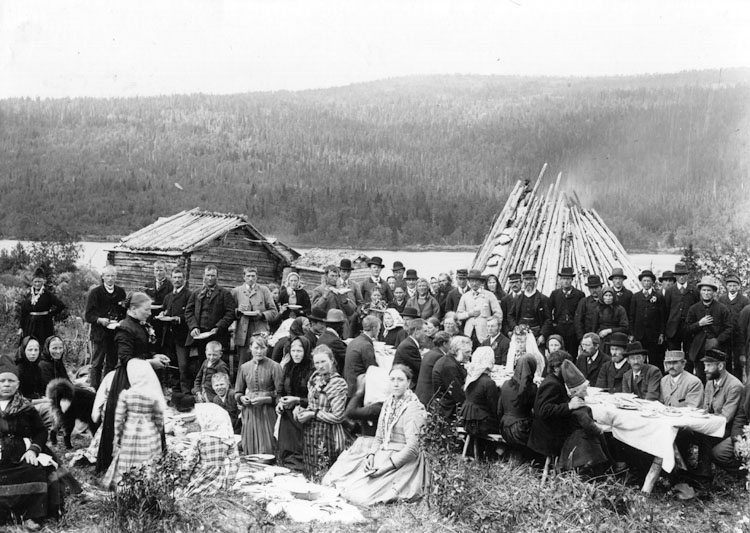
A Sámi wedding in Fatmomakke 1890 Photo: Lars Dahlstedt
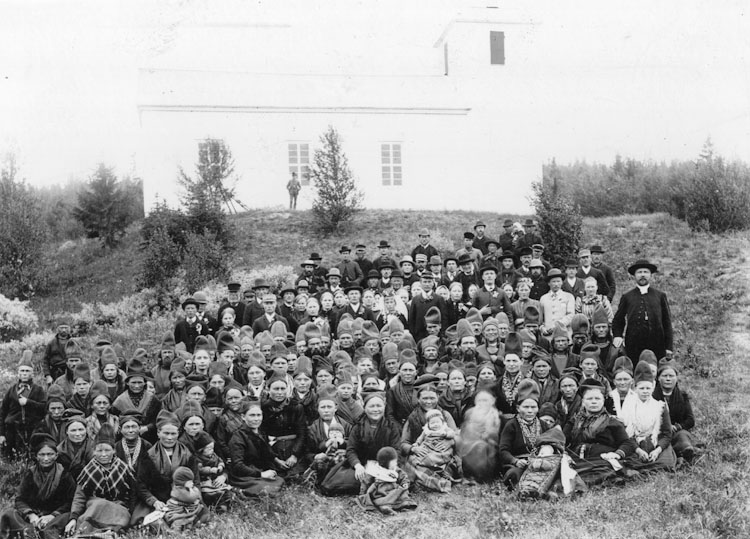
The Fatmomakke parish in front of the new church 1899 Photo: Lars Dahlstedt
The Sámi religion was destroyed and abolished in the 18th century by the Swedish Church, and during Lars’ time as a priest most Sámi had become Christian. The Fatmomakke parish asked Lars Dahlstedt for a bigger church since the old one was too small. The new church was built collaboratively by Sámi and settlers in 1899, a decision made by Lars Dahlstedt. Kjellström writes about how this was a time of amity and neighborliness between settlers and the Sámi. Older Sámi who were not strong enough for the nomadic life could stay with a settler family in exchange for a reindeer. It was common for Sámi to stay overnight with the settlers on their hikes, often with the same families. Then gifts, stories and news were exchanged and this was widely appreciated. You learned from each other, and began to embrace each other’s routines and habits. The church weekends in Fatmomakke were highly appreciated by both Sámi and settlers and an opportunity for young people to meet. However, this was a time when religiosity was characterized by fear of God’s punishment. As late as 2001, the Church of Sweden acknowledged its injustices and asked the Sámi people for forgiveness.
Now I will write something about my own residency experience at the beautiful museum home Ricklundgården.
Kalle Hedberg
I have not met that many ghosts in my life, but when I stayed alone at Ricklundgården for two weeks in February, I got really frightened now and then. I heard footsteps, and doors closing and opening. This did not happen during my residency (with Heidi S Durning and Dianne Reid) in 2009.
I started to talk politely to Emma Ricklund and Lisa Stämp. Maybe they did not want me to be there? I have always felt comfort and hope thinking about these two strong women who worked hard to make Ricklundgården a welcoming home. Emma, who struggled to reassure her house would remain a guest home even after her death. No, I was pretty sure that they both wanted me there. I talked and sang to them. The portrait of Lisa Stämp, by Kalle Hedberg, is one of my favorite paintings. Here I walk slowly next to portraits of Emma and Lisa:
Ricklundgården is over seventy years old and the sounds of the house could indeed be explained rationally, but I was too exhausted from too much work, and I really felt ill at ease. I hardly could sleep at nights. Some guest artists who have had residencies before me, like Kjersti Dahlstedt and Katarina Pirak Sikku, confirmed the ‘ghost activity’ in the museum. Gerd Ulander finally suggested that it might be the (deceased) artist Kalle Hedberg. I discussed the matter with the artist Linnéa Carlsson who also held a residency in the annex. She was very moved by my ghost talks, and one night she made a sculpture and asked me: ”Is it him?”

Sculpture by Linnèa Carlsson
And yes, it must be him. Hello Kalle Hedberg!

Self-portrait by Kalle Hedberg
Emma Ricklund was an important artistic mentor for Kalle Hedberg. Maybe Emma wanted me to be introduced to his art? Or maybe Kalle Hedberg wanted to introduce himself? I found him a bit frigthening. Here I walk next to Kalle Hedberg’s 1930 portrait of Folke Ricklund:
I found his artistic statement, and it was not very encouraging for the state I was in:
‘Talent means nothing, but the desire, the excitement is of greater value, and to struggle with the problems. The joy is to see an artist struggling and falling, instead of walking in a line with a lazy bunch. Black is the stamp of mourning, but white can open worlds, where ideas go dizzy. Art has no color. Green to yellow can coalesce, become harmonies, as well as doctrines, black and white can be as much heaven as hell. The excitement. The intensity. The unresting hell.’
I decided to look further. After some research, I found out that Kalle Hedberg not only was a close friend to Emma and Folke Ricklund, but also to Helge Dahlstedt – the son of Lars Dahlstedt. Helge Dahlstedt is my husband’s great grandfather, and it is in his wonderful cabin in Bångnäs that we still stay each summer (without electricty and water – we have to chop woods, fetch water in a creek, cook on open fire).
I found a photo of him. I see my son’s features in him. Hello Helge Dahlstedt!

Helge Dahlstedt 1885-1963
Helge Dahlstedt and his wife Eva were both practicing doctors and artlovers. Since they worked in a time before advanced medication, art was also used in therapeutic ways to heal their patients. They believed in the social responsibility of medical science and the healing power of art. Their patients, suffering from tubercolosis, at Österåsens Sanatorium in Sollefteå were surrounded by art, and artists loved to spend time there, and were offered commissioned work to decorate the hospital. Poor artists were able to pay for their stay with paintings. Helge and Eva spend a lot of time at Ricklundgården with Emma, Lisa and Folke. I also found texts where Helge wrote warmly about Sámi citizens, and he confirmed that ‘Sámi people have through time been mistreated by us Swedes’. In his book Norrland i Konsten ((the North in Art), based on a lecture he gave in 1954, he defended the Swedish artist Johan Tirén, an artist who fought for the rights of the Sámi people, for depicting the hardships of the Sámi people in a time when some people claimed that noone was interested in this kind of art any longer. Helge confirmed that the art by Johan Tirén aroused the Swede’s guilt conscience; for example paintings like ‘Thief shots of reindeer’, and this painting of a mother with her son dead in a snowstorm:
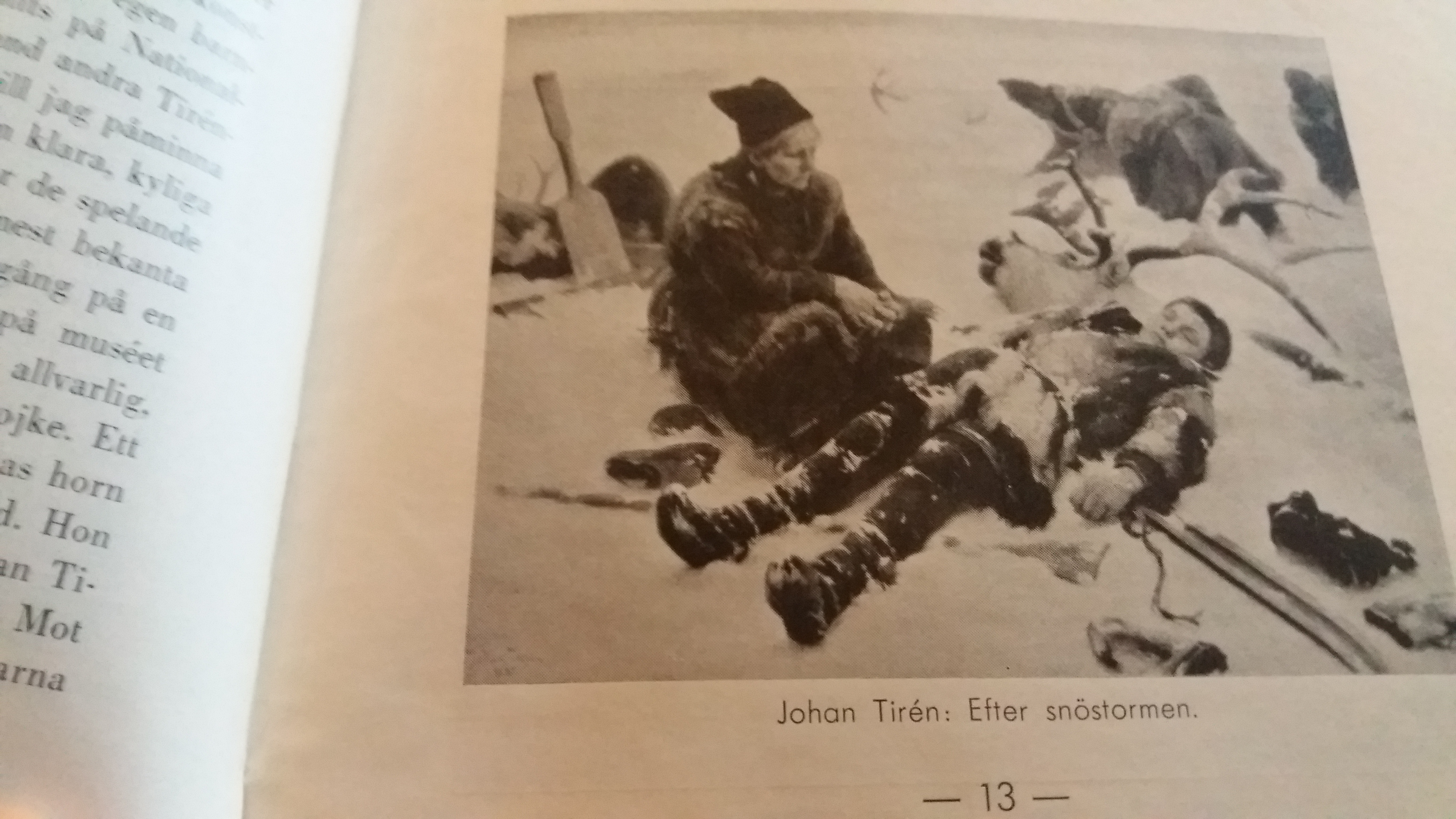
Excerpt from Helge Dahlstedt’s book Norrland i Konsten (the North in Art)
Finding these stories about the past, and understanding connections between these people, and between the Sámi and the settlers finally helped me deal with the ‘ghost activity’ in the museum. I was also lucky to have the other guest artist, Linnéa, to talk to, and I was invited to listen to jazz with Gerd and her husband Lars-Göran Ulander. I was skiing everyday, and I continued my durational arts practice with walking slowly in suriashi:
This time also on ski:
Suriashi is a walk in which you relate to your past and to your ancestors. After all the years (since 2000) I have practiced this walk with or without my teacher Nishikawa Senrei, I will finally relate to my maternal ancestors.
I was invited to an excursion to Fiskonfjäll on snow mobiles with Saara Hermannson and her beautiful parents Joel and Laila. We performed suriashi together next to their cabin:
Finally, all the international participants arrived, and the Nordic Summer University’s first winter symposium in Sápmi began, and it became a very succesfull and memorable one for all of us. Now as I am here again, I realize that the participants of the Circle 7 also have become a part of the ‘ghostly activity’ in this museum. Hello Circle 7!
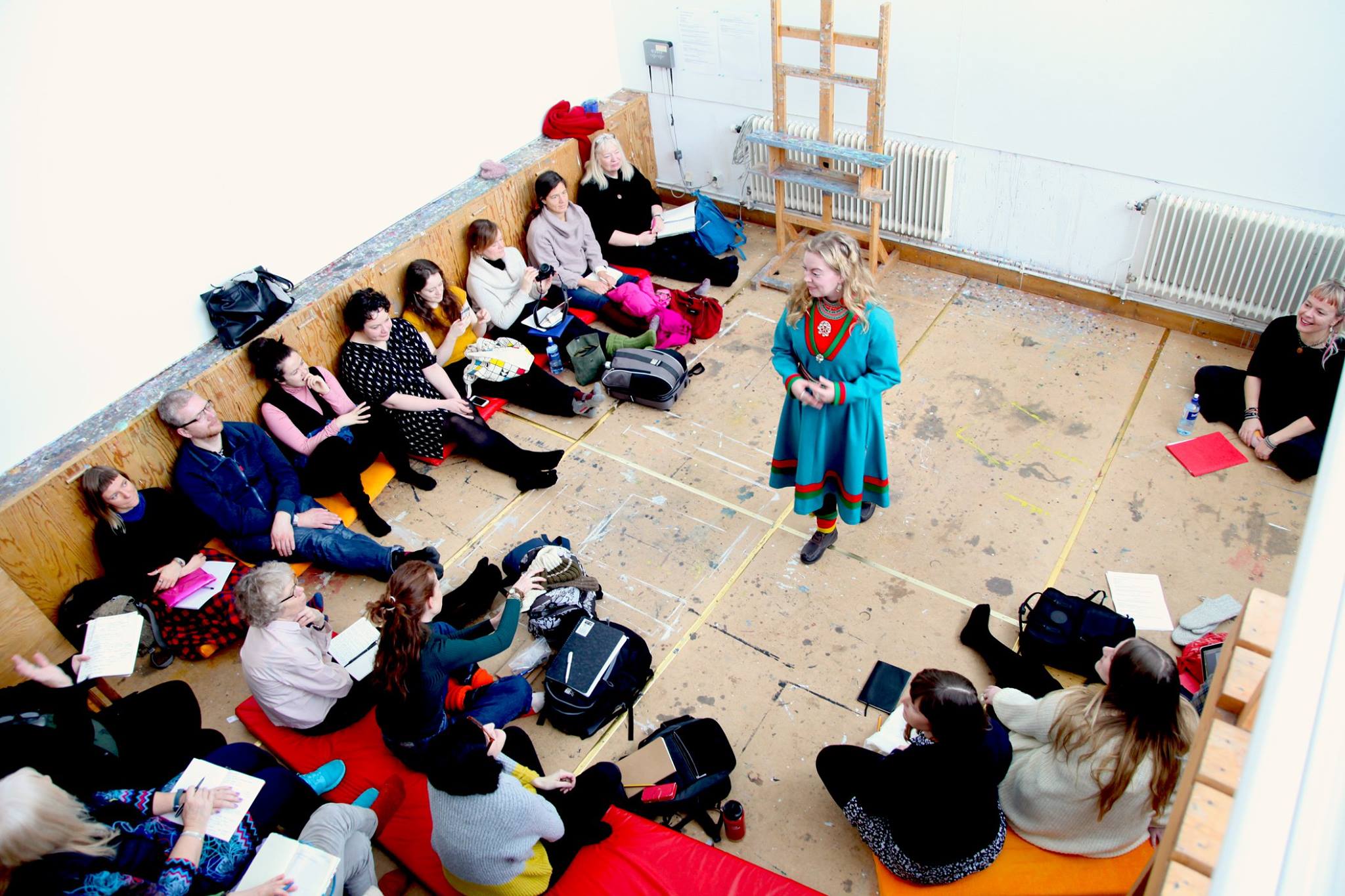
Saara Hermansson with Circle 7 in Folke Ricklund’s atelier Photo: Marina Velez

Circle 7 listening to philosophy and embroidering in the snow outside Ricklundgården 2017
In a presentation by Christine Fentz and Ragnhild Freng Dale, the contemporary Sámi film director Pauliina Feodoroff was quoted, in which she asks us not to flatter the landscape, something that deeply affected all of us. Indeed, this space is not a place for you to rest and to consume silence. It is not a postcard to be send out in the world. Saxnäs, Marsfjäll is a place where people live and work. Welcome the sound of snow mobiles as this sound shows the life in this village. Walk slowly, lean back, and relate to your ancestors. And have a happy new year.

Happy New Year 2018!!
P.S. On Feb 11th, I received an e-mail from Katarina Pirak Sikku. She writes that she was inspired by this blog post, and that she applied for a residency again at Ricklundgården. She wrote to me from the Folke atelier. She is making a hommage to her grandmothers who were originally from Kultsjödalen, the area between Saxnäs and Fatmomakke. Her grandmother was the neighbour of Lisa Stämps family. Katarina just came back from Östersund, from the 100th anniversary Sámi land meeting. In Östersund, she had met Eric-Oscar Oscarsson. He told her about the Nomad Schools that at first were organized through the Swedish church. However, there were some who did not want the Nomad school in their parishes. They thought that these Nomad schools were inhumane, and that many were treated in a bad way. Eric-Oscar Oscarsson told Katarina that there were two priests who opposed the prevailing system. One of the priests was a Dahlstedt in Vilhelmina.
This information was welcome, since I have wondered a lot about the position of Lars Dahlstedt in this time and space. I see his early 20th century opposition to the prevailing system as a healthy reminder that his attitude is something to acknowledge and replay. It might feel impossible in your own time and place, especially if your viewpoint represents a minority. But your actions will always have an impact for those who come after. No action is too small.

Dans le cadre de l’exposition « Vous tenir tout contre moi » présentée à la Galerie 0.15 Essais Dynamiques en novembre et décembre 2017, l’une des artistes, Ami Skanberg Dahlstedt donnera une conférence intitulée :
Vous tenir tout contre moi – how close can the audience come?
Cette conférence aura lieu le jeudi 9 novembre à 17h, sur le Site du Saulcy, Bâtiment A de l’UFR ALL-Metz, amphi 3.
En espérant vous y voir nombreux-ses.
